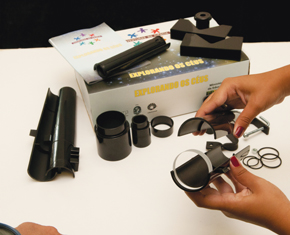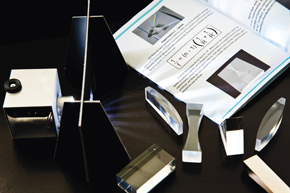
Léo RamosUsing new versions of science kits originally developed in the 1970s, students can perform real experiments…Léo Ramos
A panel at the entrance to the University of São Paulo Chemistry Institute (USP) invites people to spend a few minutes at an open-air laboratory where they can conduct experiments using samples of chemical compounds and simple lab instruments, like microtubes and plastic spatulas, laid out across a long table. Since September 2014, when Prof. Henrique Eisi Toma launched the initiative, hundreds of guests, which have included USP students as well as visiting pupils from public and private high schools, have set off over 2,000 chemical reactions. The main attraction at this makeshift laboratory is the chemistry kit from the Adventures in Science collection, developed eight years ago by researchers from USP, the Federal University of Rio de Janeiro (UFRJ), and the University of Campinas (Unicamp). Toma, who is part of the group, also uses this material in a distance learning class on science teaching that is offered to elementary education teachers through the São Paulo State Virtual University (Univesp). “The goal is to make it more fun and dynamic to learn science,” the professor says.
The experience is set to go nationwide this year. Under a cooperation agreement signed with the Ministry of Education (MEC) in 2013, one million science kits will be distributed to over 22,000 public schools across the country. But actual implementation of the project depends on the resumption of talks with the ministry, interrupted in 2014 by the national elections. “Our group will be responsible for managing the program and training the instructors,” explains physicist Vanderlei Bagnato, a professor at the São Carlos campus of USP and one of the project coordinators. He and Toma are joined on the team by physicist Herch Moysés Nussenzveig, from UFRJ; astronomer Beatriz Barbuy, mathematician Eduardo Colli, and biologists Mayana Zatz and Eliana Dessen, from USP; and FAPESP’s Scientific Director, Carlos Henrique de Brito Cruz.

Léo Ramos… with chemical compounds (chemistry kit) and observe cell structure through a microscope (biology kit)Léo Ramos
The Adventures in Science collection drew its inspiration from Os Cientistas (The scientists), a series of booklets released in 1972 at the initiative of USP professor emeritus Isaias Raw and the former Brazilian Foundation for Science Teaching, in partnership with Editora Abril publishing house. Sold in styrofoam boxes at newsstands, the kits came with simple material for replicating experiments related to the discoveries of world-renowned scientists; they also included an instruction manual and a biographical booklet. One of the booklets, for instance, was about the British chemist and physicist Michael Faraday; to test his law of induction, the kit supplied a magnet, some wire, a reel, and batteries.
The idea of resuscitating the kits surfaced in 2006, when Nussenzveig suggested it to Mayana Zatz, then Dean of Research at USP; Prof. Isaias Raw; and Roberto Civita, then president of Editora Abril, as well as representatives of FAPESP, MEC, and the Brazilian Innovation Agency (Finep). “In 2009, we realized it would be hard to put the kits back in newsstands. Then Roberto Civita suggested selling them to MEC, exclusively for classroom use,” reports Nussenzveig. That same year, a prototype was made of the first kit, which explores light beam optics. In 2011, a few models were presented to the heads of the Brazilian Federal Agency for the Support and Evaluation of Graduate Education (Capes), part of MEC; the agency then decided to fund a preliminary survey at public schools. In 2012 and 2013, some 6,000 kits were distributed to over 2,000 students around the country. According to the survey report, 80% of the students found the kits of interest and stated that the proposed activities stimulated creativity; 60% said they felt motivated to get together with their classmates and family to talk about science.

Léo RamosThe math kit uses dice and games to teach probabilityLéo Ramos
In another question, 57% of the students reported that the instructions included in the kits were easy to read and understand. However, 66% said the text of the manuals should be clearer and more concise. “With this in mind, we rewrote the manuals using language better tailored to a young audience,” says Eliana Dessen, a professor at the USP Biosciences Institute and coordinator of education and dissemination at the Human Genome and Stem-Cell Research Center, one of FAPESP’s Research, Innovation, and Dissemination Centers (RIDC). She and Mayana Zatz were responsible for developing the biology kit.
A good share of the students also complained that practical classes are not offered. Few students in Brazil have the opportunity for direct contact with science laboratories over the course of their primary education. Data from the National Institute for Educational Studies and Research (Inep), a MEC agency, showed that only 10.6% of Brazilian schools—public and private alike—enjoyed this kind of structure in 2012. “Laboratories are vital tools when it comes to providing training and making science learning more attractive. But in Brazil, it’s not part of the culture to value these sorts of activities,” says physicist Luís Carlos de Menezes, a professor at the USP Physics Institute and a specialist in science teaching.

Léo RamosThe Galileoscope™: an instrument similar to the one Galileo used to observe the heavensLéo Ramos
According to the survey report, only 7% of the interviewed students expressed satisfaction with science teaching. This fact was the chief incentive for bringing the science kits back. However, Mayana Zatz, geneticist, stresses that the kits are not meant to replace classes in an actual laboratory. “Laboratories have infrastructure for conducting more complex experiments. The kits are individual resources, like little home laboratories, for doing experiments” says Zatz. Still, the kits do play the role of demystifying a number of concepts addressed in the classroom. Roughly 67% of the students said it was only after they had interacted with the kits that they managed to fully understand a scientific concept.
At Professor Lordão State High School, in Picuí, Paraíba, for example, 25 science kits were tested as part of a project by Prof. Alecxandro Alves Vieira, of the Federal University of Campina Grande (UFCG). “I’ve had a lot of different experiences in teaching and learning, and the science kit was among those that yielded the most satisfying results,” he says. According to a 2013 report, shortly after the kits were used at schools, group activities revolving around the kits were found to foster greater dialogue among students and a greater division of labor—something that is rarely explored in lecture-format classes.
Although the kits draw inspiration from the 1970s models, the new versions had to be adapted to today’s reality. The old biology kits, for example, contained sharp instruments like scalpels, as well as biological tissues. “Today, those kits would never get the approval of quality control agencies, like the National Institute of Metrology, Quality, and Technology (Inmetro),” Eliana Dessen points out. The new biology kit looks at cell diversity and at structures made visible through optical microscopy. The new kits do not come with prepared samples of biological material but instead encourage the students to gather materials around them, like algae, plants, dead insects, drops of water, and pieces of fruit or vegetables. The instruction manual explains how to prepare a laboratory slide, which will be enlarged 75, 150, and 400 times under a microscope. Dessen says the kit has been used in an RIDC project. “We go around to public schools in the city of São Paulo and set up traveling laboratories, which remain accessible for three weeks. Sixty schools will be reached in 2015,” she says.

Léo RamosThe optics kit relies on prisms and mirrors to demonstrate basic concepts in physics, like the reflection of lightLéo Ramos
The chemistry kit also underwent remodeling. The old version contained material that could be dangerous when handled, like sulfuric acid. Henrique Eisi Toma replaced it with sulfamic acid, which is solid, safer, and doesn’t have a strong odor. All reagents were specially chosen for their safety, toxicity, stability, and ease of handling. Another change was the quantity of material. “The experiments were adapted for the micro-scale. With just one drop of material, for instance, it’s possible to take electrochemical measurements and understand how a battery works,” Toma explains. Glass equipment, like test tubes, was also replaced with smaller plastic versions; in calculations of acidity (pH), emphasis was placed on using products found in the home, such as vinegar and bleach. Small plastic tubes were transformed into devices for experiments with gas, while drinking straws cut at an angle now serve as spatulas.
“We want to introduce young people to science as a practice. From early on, students are taught how to deal with the final results of research but not with the process,” says Vanderlei Bagnato, responsible for the physics kit, which features the field of optics. Amidst prisms, concave and convex mirrors, and lenses, young people have the chance for a close-up look at the paths traced out by light beams. Bagnato explains that new physics kits have already been designed and will focus on specific topics like color, eyesight, and sensation; waves and the thermodynamics of gases; and geology. Some of these are now being tested by high-school students and teachers in São Carlos.
The mathematics kit also concentrates on a specific subject within the field: probability. “By using objects like dice and little balls, you can experience mathematics physically, instead of simply accepting its propositions,” says Eduardo Colli, a professor at the USP Institute of Mathematics and Statistics. The experiments are performed using dice of different shapes and other resources, like a box for simulating a Secret Santa drawing and rattle-like cylinders that contain an unknown number of little balls. What is interesting about the latter experiment is that the student doesn’t know the exact number of total balls but can only arrive at an estimate, because the kit doesn’t come with an answer sheet. “The idea is to show the student that science is ripe with questions without solutions,” Colli says.
The astronomy kit is the only one of the five that cannot be used in the classroom. Its experiments all involve the Galileoscope™, an optical instrument for viewing heavenly bodies as Galileo observed them more than 400 years ago. The telescope was re-created in 2009 by the American Astronomical Society and adopted by the International Astronomical Union for the International Year of Astronomy. It can be used to see the lunar craters, the phases of Venus, and Jupiter’s satellites, for example. “Rediscovering do-it-yourself science, without a lot of digital resources, is a liberating experience,” says Beatriz Barbuy, a professor at USP. In their new version, the kits also offer classes and explanations in video format.
Republish